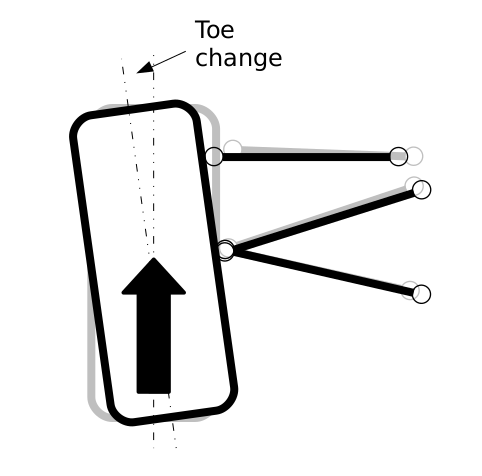Traction Steer – Suspension KPI
Traction steer is a measure of the toe angle change in a suspension system when it is subject to a longitudinal force applied at wheel centre. Traction steer is measured as degrees of toe change per Kilo-Newton of force at the wheel centre, Deg/kN.

The name traction steer implies a forward force due to a forward driving force from the engine as shown in the image above. On most suspension systems it can be difficult to tune traction steers independently from brake steer. Due to the safety critical nature of braking, brake steer (rearward longitudinal force at the tyre contact patch) is always prioritised to give understeer behaviour, therefore traction (forward longitudinal force at wheel centre) will give an oversteer tendency to the wheel (toe in on the front axle, toe out on the rear axle).
There is a benefit to this when we consider an impact scenario where the wheel centre is forced rearwards by an input from the road surface. The oversteer tendency under traction now gives an understeer tendency due to the impact. Consider the driving scenario where a suspension system receives an impact force (e.g. pothole) during a cornering event. In this scenario, the understeer tendency from the suspension system would cause the vehicle to widen its line after the impact. This understeer tendency is more predictable and intuitive to the average driver than a car that tightens its line under the same scenario.
That said, it is often desirable to keep traction steers small, but this is not always possible due to the link with brake steer. Typically in production cars traction steers can be between ~0.0 and 0.1 Deg/kN
—
ENHANCE YOUR CHASSIS AND SUSPENSION SYSTEMS EXPERTISE WITH CUTTING-EDGE SOFTWARE SOLUTIONS AND SUSPENSION COURSES
AUTOMOTIVE/MOTORSPORT SUSPENSION AND CHASSIS SYSTEMS – DESIGN AND ENGINEERING FUNDAMENTALS COURSE
SUSPENSION PERFORMANCE TUNING USING MULTIBODY SIMULATION SOFTWARE COURSE
START USING RACE SOFTWARE TODAY WITH A FREE TRIAL ON ALL PLANS
